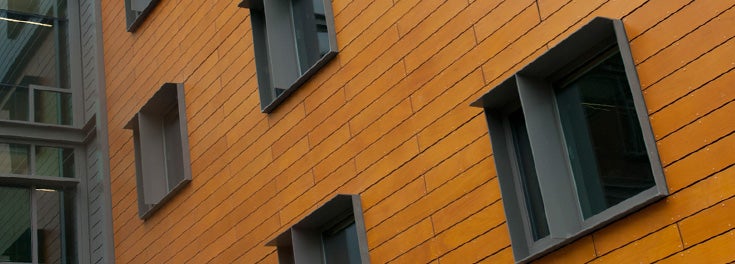Hillside Hall gives a whole new meaning to “green living.” URI’s newest residence hall, home to 429 pharmacy, nursing, and international students, was designed with leadership in energy and the environment in mind.
Its water is heated by the 64 solar panels on the roof, while landscaping controls and filters storm water before it enters nearby White Horn Brook. The four-story glass-faced bridge that connects Hillside’s two wings makes generous use of available light while sun shading and window vents allow for ample airflow and ventilation. And there’s also green roofing, radiant heat, recycled building materials, and no touch water fountains.
Green buildings are just the beginning of all that’s green at URI. We’ve been recognized by the Princeton Review as one of the nation’s greenest colleges for four consecutive years—scoring higher on the green rating scale than any other Rhode Island school.
But Hillside isn’t the only green building on campus. To name a few—the super-sunny, energy-efficient pharmacy building with its unique air handling and heating and cooling systems, the Center for Biotechnology and Life Sciences with its “vegetative” roof that filters pollutants and reduces heating and cooling needs, the award-winning Hope Commons Dining Hall, and several other residence halls, LEED certified for their eco-friendly design and features.
Green buildings are just the beginning of all that’s green at URI. We’ve been recognized by the Princeton Review as one of the nation’s greenest colleges for four consecutive years—scoring higher on the green rating scale than any other Rhode Island school for academic programs, student activities, and other initiatives intended to demonstrate and teach a commitment to sound environmental stewardship.
The URI Climate Action Plan aims to reduce campus emissions to 45 percent by 2020—through upgrades to lighting and heating/ventilation systems, installation of pool covers, and more efficient light fixtures. We converted our research vessel, the Endeavor, to run on refined biodiesel, making it the first research ship in the U.S. fleet to use alternative fuel. Much of the produce used in campus dining halls is grown on University farmland or gardens by students in the Food Agriculture Program (other foods are bought only from local farmers), and used cooking oil is sold to a local company to be converted to biodiesel. The Student Senate launched a car-share program to reduce traffic on campus and reduce greenhouse gas emissions. The Sustainability Club competes in the U.S. Environmental Protection Agency’s annual Game Day Challenge. And the Renewable Energy Club is studying the feasibility of installing a wind turbine at the Narragansett Bay campus to reduce reliance on fossil fuels.
Our students take pride in living an environmentally sound lifestyle, but many also want to pursue careers that put their passions to work. So this year, we launched one of the nation’s first undergraduate programs focused on green business—a four-year, dual-major program that combines business and environmental economics. And there’s our “Blue MBA”—a graduate program that blends business with oceanography, preparing future leaders in the strategic management of global climate change.
Industrial engineering students are helping manufacturers worldwide design products to be repaired and recycled, rather than replaced. Our landscape architecture students work on community design projects for surrounding towns, with safe pedestrian and bicycle travel in mind. And an interdisciplinary team of students and faculty are providing the research foundation for Rhode Island’s planned offshore wind farm.
“We have a big responsibility to set a good precedent and be a role model for the community,” says Marsha Garcia, the University’s campus sustainability officer. “It’s our responsibility to make sure students have command of the principles for sustainability when they leave the University, so they can incorporate them into their lives. This is the perfect living laboratory.”

